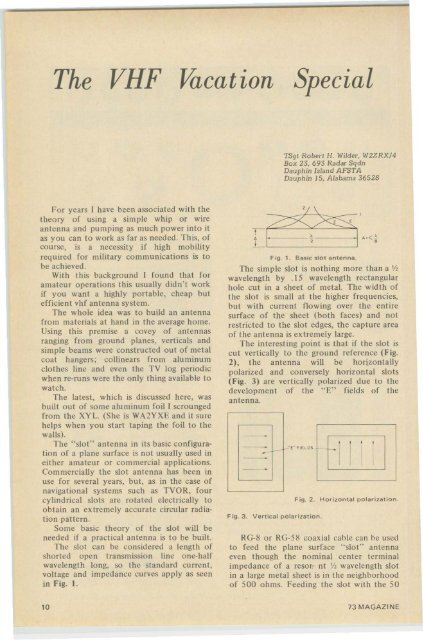rf - Free and Open Source Software
rf - Free and Open Source Software
rf - Free and Open Source Software
- No tags were found...
You also want an ePaper? Increase the reach of your titles
YUMPU automatically turns print PDFs into web optimized ePapers that Google loves.
The VHF TiLcation Special<br />
TSgt Robert H. WHd er, W2ZRX/4<br />
Bo x 23, 693 Radar Sqdn<br />
Dauphin Isl<strong>and</strong> AFSTA<br />
Dauphin 15, Alabama 36528<br />
For years I have been associated with the<br />
theory of using a simple whip or wire<br />
antenna <strong>and</strong> pumping as much power into it<br />
as you can to work as far as needed. This, of<br />
course, is a necessity if high mobility<br />
required for military communications is to<br />
be achieved.<br />
With this background I found that for<br />
amateur operations this usually didn't work<br />
if you want a highly portable, cheap but<br />
efficient vhf antenna system.<br />
The whole idea was to build an antenna<br />
from materials at h<strong>and</strong> in the average home.<br />
Using this premise a covey of antennas<br />
ranging from ground planes, verticals <strong>and</strong><br />
simple beams were constructed out of metal<br />
coat hangers; collinears from aluminum<br />
clothes line <strong>and</strong> even the TV log periodic<br />
when re-runs were the only thing available to<br />
watch.<br />
The latest, which is discussed here, was<br />
built out of some aluminum foil I scro u nged<br />
from the XYL. (She is WA2YXE <strong>and</strong> it sure<br />
helps when you start taping the foil to the<br />
walls).<br />
The "slot" antenna in its basic configuration<br />
of a plane su<strong>rf</strong>ace is not usually used in<br />
either amateur or commercial applications.<br />
Commercially the slo t antenna has been in<br />
use for several years, but, as in the case of<br />
navigational systems such as TVOR, four<br />
cylindrical slo ts are rotated electrically to<br />
obtain an extremely accurate circular radiation<br />
pattern.<br />
Some basic theory of the slot will be<br />
needed if a practical antenna is to be built.<br />
The slot can be considered a length of<br />
shorted open transmission line one-half<br />
wavelength long, so the st<strong>and</strong>ard current,<br />
voltage <strong>and</strong> impedance curves apply as seen<br />
in Fig. I.<br />
Fig. 3.<br />
'--<br />
,-<br />
>-<br />
,<br />
A.< b.<br />
,<br />
Fig. 1.<br />
_'E"l'IELOS<br />
Fig. 2 .<br />
Vertical polarization.<br />
'J \<br />
.> z.~<br />
Basic slot antenna.<br />
The simple slot is nothing more than a %<br />
wavelength by . I 5 wavelength rectangular<br />
hole cut in a sheet of metal. The width of<br />
the slot is small at the higher frequencies,<br />
but with current flowing over the entire<br />
su<strong>rf</strong>ace of the sheet (both faces) <strong>and</strong> not<br />
restricted to the 5101 edges, the capture area<br />
of the antenna is extremely large.<br />
The interesting point is that if the slot is<br />
cut vertically to the ground reference (Fig.<br />
2), the antenna will be horizontally<br />
polarized <strong>and</strong> conversely horizontal slots<br />
(Fig. 3) are vertically polarized due to the<br />
development of the "E" fields of the<br />
antenna.<br />
-<br />
- - - - -<br />
- •<br />
-.<br />
,<br />
• • •<br />
I<br />
I<br />
Horizontal polarization.<br />
RG-8 or RG-58 coaxial cable can be used<br />
to feed the plane su<strong>rf</strong>ace "slot" antenna<br />
even though the nominal center terminal<br />
impedance of a rcsor- nt 1f2 wavelength slot<br />
in a large metal sheet is in the neighborhood<br />
of 500 ohms. Feeding the slot with the SO<br />
10 73 MAGAZINE

















